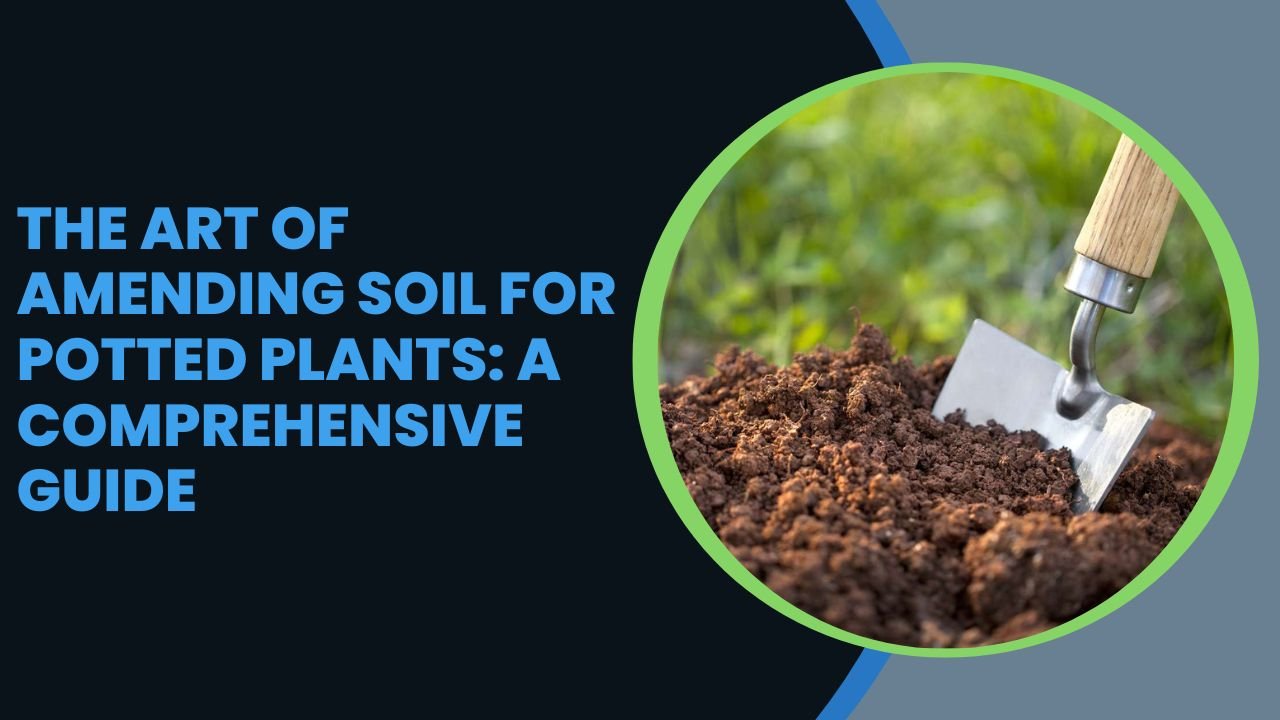Potted plants bring nature’s beauty indoors and offer an opportunity to cultivate greenery even in limited spaces. However, to ensure their optimal growth and overall well-being, it’s crucial to provide them with suitable soil. Soil amendment plays a vital role in enhancing the quality and fertility of potted plant soil, allowing plants to thrive and flourish.
In this comprehensive guide, we will explore the art of amending soil for potted plants, discussing the importance of soil amendment, identifying signs of poor soil, understanding essential nutrients, exploring common soil amendments, learning how to test soil, and providing step-by-step guidance for successful soil amendment.

Why is Soil Amendment Important?
Soil amendment is essential for potted plants as it addresses common issues associated with the quality of soil. Regular potting soil tends to degrade over time, losing vital nutrients and becoming compacted.
This degradation can result in poor drainage, inadequate aeration, and imbalanced nutrient levels, leading to stunted growth, nutrient deficiencies, and increased susceptibility to diseases. Amending the soil replenishes essential nutrients, improves drainage, enhances aeration, and promotes overall soil health, creating an optimal growing medium for potted plants.
Understanding Potted Plant Soil
Before delving into soil amendment, it’s crucial to understand the composition of potted plant soil. Typically, potting soil is a blend of organic matter, such as peat moss or compost, and inorganic materials like sand, vermiculite, or perlite.
The organic matter provides nutrients and retains moisture, while the inorganic components improve drainage and aeration. However, over time, these materials break down, depleting the soil’s fertility and structure, necessitating soil amendment.
Signs of Poor Soil in Potted Plants
Identifying signs of poor soil is essential for recognizing the need for amendment. Some common indicators include slow or stunted growth, yellowing or browning leaves, wilting, root rot, and pest infestations. Additionally, if the soil in your potted plants becomes waterlogged, compacted, or dries out quickly, it may require amendment to restore its balance and health.
Essential Nutrients for Potted Plants
Potted plants rely on specific nutrients for healthy growth. These nutrients include macronutrients like nitrogen (N), phosphorus (P), and potassium (K), as well as secondary nutrients and micronutrients. Understanding the nutrient requirements of different plant species is crucial for successful soil amendment, as it allows for targeted supplementation to address any deficiencies.
Common Soil Amendments
Soil amendments can be broadly categorized as organic or inorganic. Organic amendments, such as compost, aged manure, or leaf mold, improve soil structure, increase nutrient content, and enhance water-holding capacity.
In contrast, inorganic amendments, like perlite, vermiculite, or sand, aid in improving drainage, aeration, and preventing soil compaction. Combining both types of amendments can yield the best results, creating a balanced and fertile growing medium.
How to Test Soil for Amendments
Before amending the soil, it’s crucial to assess its current condition and nutrient levels. Soil testing kits or professional soil analysis can provide valuable insights into the soil’s pH, nutrient content, and composition. This information helps determine the specific amendments required and ensures the most effective use of resources.
Amending Soil for Different Plant Types
Different plants have unique soil requirements, and understanding these variations is essential for successful soil amendment. Some plants prefer acidic soil, while others thrive in alkaline conditions. Researching the specific needs of your plants and adjusting the soil composition accordingly can optimize their growth and overall health.
Step-by-Step Guide for Soil Amendment
To amend the soil for potted plants effectively, follow these step-by-step guidelines:
- Prepare the necessary materials and tools.
- Choose the appropriate amendments based on soil test results and plant requirements.
- Remove the plant from its pot, gently loosening the root ball.
- Mix the amendments with the existing soil or replace it entirely, depending on the severity of the soil issues.
- Replant the potted plant, ensuring proper positioning and firming the soil around the root ball.
- Water the plant thoroughly and monitor its progress, making adjustments as necessary.
Maintaining Soil Health
Soil amendment is an ongoing process, and maintaining soil health is crucial for long-term plant vitality. Regularly monitor soil moisture levels, provide adequate drainage, and adjust watering practices based on plant needs. Additionally, periodic supplementation with organic matter, such as compost or organic fertilizers, helps replenish nutrients and sustain soil fertility.
Avoiding Over-Amendment
While soil amendment is beneficial, it’s essential to avoid over-amending the soil. Excessive amendments can disrupt the delicate balance of soil components and lead to nutrient imbalances. It’s important to follow the recommended application rates and avoid excessive reliance on specific amendments, ensuring a holistic and sustainable approach to soil health.
Conclusion
Amending soil for potted plants is an art that involves understanding the specific needs of plants, identifying signs of poor soil, and applying suitable amendments. By improving soil fertility, drainage, and nutrient content, we can create an optimal growing medium that fosters healthy plant growth and development. Regular soil testing, targeted supplementation, and attentive maintenance are key to sustaining soil health and ensuring the long-term success of potted plants.
Frequently Asked Questions (FAQs)
How often should I amend the soil in my potted plants?
The frequency of soil amendment depends on several factors, including plant type, soil quality, and environmental conditions. Generally, it’s recommended to amend the soil every 6-12 months or as needed.
Can I use garden soil for potted plants?
Garden soil is not suitable for potted plants as it can be too dense and lack proper drainage. It’s best to use a high-quality potting mix or create a customized blend for optimal results.
Are there any natural alternatives to chemical fertilizers for soil amendment?
Yes, several natural alternatives, such as compost, aged manure, or organic fertilizers, can effectively amend the soil and provide essential nutrients to potted plants.
Can I reuse the soil from old potted plants?
Reusing soil from old potted plants is possible, but it’s important to refresh and amend the soil before replanting to replenish its nutrients and optimize its structure.
